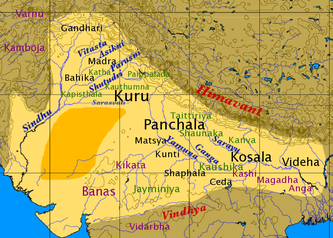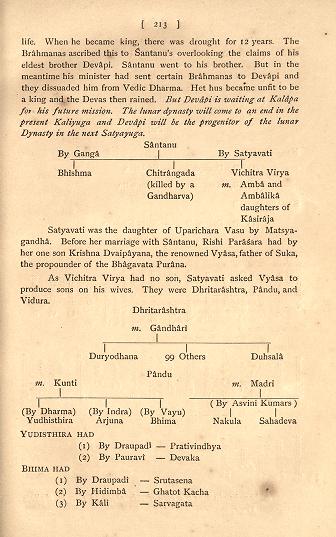Gandhari
Gāndhārī गाँधारी was the daughter of Subala, the king of Gandhara (modern day Kandahar), a region spanning northwestern Pakistan and eastern Afghanistan, from which her name is derived. Gandhari's marriage was arranged to Dhritarashtra, the eldest prince of the Kuru kingdom.
Gandhari voluntarily blindfolded herself throughout her married life. Her husband Dhritarashtra was born blind, and on meeting him and realizing this, she decided to deny herself the pleasure of sight that her husband could never relish.
Contents
Mention by Panini
Gandhari (गान्धारी) is mentioned by Panini in Ashtadhyayi. [1]
100 sons of Gandhari
Gandhari bore a hundred sons, (collectively known as the Kauravas), and one daughter Dushala who married Jayadratha. The Kaurava, principally Duryodhana and Dushasana, were the villains of the Mahabharata, and were all killed in their war against their cousins, the Pandava, at Kurukshetra.
Although Gandhari's sons were portrayed as villains, the Mahabharata attributes high moral standards to Gandhari. She repeatedly exhorted her sons to follow dharma and make peace with the Pandavas. Gandhari was especially close to Kunti who respected her like an elder sister.
Gandhari made a single exception to her blindfolded state, when she removed her blindfold to see Duryodhana rendering his entire body except his loins invulnerable to any foe. This was however to prove fruitless as Bhima smashed Duryodhana's thighs in their decisive encounter on the eighteenth day of the Kurukshetra battle.
Gandhari was also devout; in particular an ardent worshipper of Lord Shiva. Gandhari's sacrifice of her eyesight and her austere life was to grant her great spiritual power. Gandhari's anguish in the loss of her hundred sons resulted in her cursing Krishna in effect ensuring the destruction of the Yadavas. It is also said that through a small gap in the napkin in which her eyes were blindfolded, her gaze fell on Yudhisthira's toe. The toe was charred black due to her wrath and power. Gandhari ended her life with her husband and her sister-in-law Kunti in the Himalayas, where they died in a forest fire.
Afghanistan was part of Bharat Varsh during Mahabharata period. The wife of Dhritrashtra, Gandhari, was from this area. Sometimes there were Indian rulers and sometimes there were Iranian rulers in Afghanistan. During Chandra Gupta’s period Saubhagsen was king in Afghanistan. Jat rulers till the invasion by Mughals ruled Kandahar. After the Mughal invasion some Jats moved to India and others were converted to Muslims. Jats from Afghanistan moved to India during the rule of Shalivahan. According to Henry Eliot, author of the book “Distribution of the races of north western provinces of India”, The Jats settled on the banks of Chenab River in Punjab, call there area as Herat because they believe that they had come from Herat of Iran. According to Thakur Deshraj the present Sistan was ruled by Jats and that area was known as Shivistan (place of Shivi gotra Jats). Cunningham states that Jats mixed with Rajputs and Afghans. Later these people were called Bloch.
Jat Gotras after Gandhari
Gandhar (गंधार)/ Gandhari (गंधारी)[2] Gandhar (गांधार) Gandila (गंडीला) Gadir (गडीर) gotra of Jats originated from place named Kandahar in Afghanistan. Kandahar became Gandhar and people were also known by name Gandhar. They are also called so being the descendants of Gandhari of Mahabharata. [3] They find mention in Mahabharata Shalya Parva shloka 26:
- जयशब्दं ततश चक्रुर देवाः सर्वे सवासवाः
- गन्धर्वयक्षा रक्षांसि मुनयः पितरस तदा |26|
- jayaśabdaṃ tataś cakrur devāḥ sarve savāsavāḥ
- gandharvayakṣā rakṣāṃsi munayaḥ pitaras tathā |26|
According to Jat historian Ram Swarup Joon, "Afghanistan was called Upguanstan, Baluchijostan both of that are Sanskrit words. Both these countries were part of India till, as late as the Mogul period. King Seth of the Ardas branch of Yayati dynasty had a son called Arh, whose son Gandhara founded the town of Gandhar, now known as Kandhar. Gandhari, mother of Duryodhana was from this town. Jats have gotras of this dynasty named Gaina, Gaindhar, Gaindhala and Gaindhu.
Gandhari clan in Afghanistan
H. W. Bellew [4] writes that Gandhari of the Sanskrit writers, and Gandarioi of the ancient Greeks — now inhabit a small canton called Nawagai, of which the capital is Gandhar, a town said to contain four thousand houses ; the country lies north of the Kabul river, between its Kunar tributary and the Bajaur hills. The Gandari are now reckoned among the clans of the Safi tribe, and are counted at about three thousand families. The celebrated Akhund of Swat, Abdul Ghafur by name, a religious recluse of considerable local sanctity and influence, some few years ago was a Gandharai, though commonly called a Safi, of which tribe the Gandhari or Gandari is a principal clan. The Safi is a considerable tribe inhabiting the Lughman district, and lower valleys at the base of the Kafiristan hills, from the Alishang river round to the Kunar. They are a fair and manly race, speak a dialect of their own, and are commonly reckoned as a branch of the Pashai. Some Safi I have met wore ringlets on each temple, and had the
[Page-64]: top of the head close cropped, much after the fashion of Oriental Jews.
Anciently the Gandhari were a numerous and important people, and gave their name to the whole country lying between the Indus and Kabul rivers, and drained by the Swat river and its affluents; its Indus border extending from Attock to Kanra Ghorband, below Gilgit. This country is the Gandhara of Sanskrit authorities, and may be taken to represent that of the Gandarioi of Herodotus ; its southern boundary being the Kabul river eastward of the Kunar junction ; and its western the watershed of the Bajaur range separating it from the valley of the Kimar river; the northern boundary is formed by the high mountains dividing this tract from the Darada country. The Gandaritis of Strabo had a much smaller area, and was restricted mostly to the plain country (or Sama) between the junction of the Kabul and Indus rivers; and perhaps more particularly to the Doaba portion of this tract, between the Kabul and Swat rivers.
The larger area of the Gandhara above defined comprised, besides the Doaba and Sama, all the hill country drained by the Panjkora (the Guraius of the Greeks), Swat (ancient Suastus) and Barandu rivers, and containing the cantons of Bajaur, Swat, Boner, etc., as far northwards as the Kohistan of Kanra and Ghorband, beyond which lay the country of the Dardu.
The Gandhari, or inhabitants of the Gandhara thus defined, comprised several distinct nations or tribes, of which the predominant Gandhari themselves occupied as their central seat the interfluvial tract enclosed by the Kabul, Swat, and Kunar rivers ; whilst the other nations occupied the rest of the plain country and the hill region up to the lofty mountains separating the drainage of the Swat river from that of Gilgit. The existing Gandari, or Gandhari, as before stated, are now confined to a little canton in the midst of the Nawagai hills ; the rest of their ancient country being in possession of other tribes, principally the Mahmand, of whom we shall speak presently.
Of the other nations anciently inhabiting the Gandhara country, Strabo furnishes us with the names of five, which we can easily recognise as we follow his account. He says (Geog. xv. 2) : " On his return to Baktriana from his expedition into Sogdia, and against the Skythians, Alexander, crossing the same mountains into Ariana by other roads, proceeded towards India, and the rivers Kophes (Kabul) and Khoaspes (Swat or Landi) which unite near Plemyrium (the modem village of Prang ; the Pukhto corruption probably of the Hindi Pramaraka, " of the Pramara," a well-known Rajput tribe, very largely represented amongst the Afghan tribes all along the Indus border), after the Khoaspes
[Page-65]: (khwar = River in Pukhto and Asip or Isap, the Pukhto name of the Aspioi tribe of Arrian, and of their own modem Muhammadanized Yusufzi) has passed by another city Gorys (Guri or Gori, the ruins of which are a well-known and prominent feature of the Tulash glen in Swat) in its course through Bandobene (Barawal district of Bajaur) and Gandaritis (Gandhar), and wintering in the territories of the Hypasioi (Strabo calls them Aspasioi in another passage; Arrian calls them Aspioi which is nearer to the current Pukhto Isapi or Isapzi of the modern Yusufzi) and in that of Asskanus (king of the Rajput Aswaka — " of the Aswa," a tribe anciently inhabiting the Swat valley, now represented by the Aspin of Chitral, and Yashkun or Yaskan of Yasin and Gilgit), in the beginning of spring he descended into the plains to the city of Taxila (the site of which is marked by the modern Takhal villages near the Peshawar cantonment ; not by the Taxila found east of the Indus, for Alexander has nob yet crossed that river). After the river Kophes follows the Indus. The country lying between the two rivers is occupied by the Astakenoi (Astaki tribe ; of which Astes mentioned by Arrian, was the chieftain), Masianoi (Mashwanri]] of Gandghar on east bank of Indus, previously described), Nysaioi (inhabitants of Nysaia of the Greeks, Nisida of the Rajput, and Nisatta of our day, around which are the ruins of the ancient free city ofNysaia), and Hypasioi (or Aspasioi the Aspioi of Arrian, the Isap of the Pukhtun, and the Yusufzi of the modern Musalman). Next is the territory of Assakanus (king of Swat and Bajaur, above noticed) where is the city of Masoga (if not the same as the Gorys above mentioned, perhaps its site is marked by the modern Bajaur commonly called Khahr or Shahr, " The City"), the royal residence of the country. Near the Indus is another, Peukalaitis (its site is perhaps marked by the ruins of Beka, on the Indus bank below Topi), for at this place a bridge which was constructed afforded a passage for the army."
Arrian gives a more particular account of Alexander's course through the country above described. He says in effect (Bk. iv. 224 et seq,) that Alexander, after the reduction of Sogdia, marched back into Baktria, whence, at the approach of spring (327 B.C.), he pushed forward with all his forces for India, and passing over Mount Caucasus, arrived at Alexandria, the city he had built among the Parapamisai, when he made his first expedition into Baktria. From this passing forwards to Nikaia (Nijrao) he proceeded to the river Kophenes (Kao of Dara Najil, where it joins Kabul river). Here, dividing his forces, he despatched Hephaistion and Perdikkas with a division of the army into the country of Peukalaotis (identified by Cunningham— 'Ancient Geography
[Page-66]: of India" — with the Sanskrit Pushkalavati the ancient capital of Gandhara, and situated on the East bank of the Swat or Landi river near its junction with the Kabul stream), towards the river Indus, the prince of which was called Astes (chieftain probably of the Astakenoi of Strabo, and governor of their capital city, now represented by the modern Charsada, commonly called Hashtnagar, indicating a former name of the sort, most likely Hastinagar, " City of the Hasti"; for Hashtnagar is a compound Persian and Hindi word meaning " eight cities," and has hence been vulgarly applied to as many villages along this river, and to the district in which they are situated).
External Links
गांधारी: भारतकोश, ज्ञान का हिन्दी महासागर
References
- ↑ V. S. Agrawala: India as Known to Panini, 1953, p.49, 425
- ↑ Dr Ompal Singh Tugania: Jat Samuday ke Pramukh Adhar Bindu, p.34, sn-524.
- ↑ Dr Mahendra Singh Arya, Dharmpal Singh Dudee, Kishan Singh Faujdar & Vijendra Singh Narwar: Ādhunik Jat Itihas (The modern history of Jats), Agra 1998 p. 236
- ↑ An Inquiry Into the Ethnography of Afghanistan By H. W. Bellew, The Oriental University Institute, Woking, 1891, p.63-66
Back to The Ancient Jats

